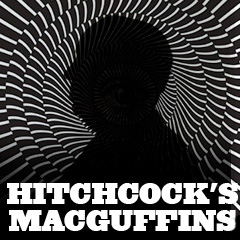Hitchcock's MacGuffins
WARNING:
There are lots of spoilers here
|
Film Title
(chronological order)
|
Identification of MacGuffin(s)
|
Screenshots of MacGuffin(s)
|
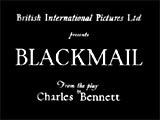
Blackmail (1929)
|
- the MacGuffin: a pair of women's gloves found
at the crime scene
- in the story, a London woman named Alice White (Anny
Ondra) murdered an artist (of harlequins) named Mr. Crewe
(Cyril Ritchard) who tried to rape her in his Chelsea art studio;
she defended herself with a bread-knife and stabbed him to death;
as she fled his studio, she accidentally left behind her gloves
- Scotland Yard Detective Frank Webber (John Longden),
Alice's beau-boyfriend, was coincidentally assigned to investigate
the homicide case; at the crime scene, when he located one glove
and realized it belonged to Alice, he concealed it from other colleagues,
knowing that it would incriminate Alice as the killer
- Alice's blackmailer was petty criminal Tracy (Donald
Calthrop), who had seen Alice enter Crewe's studio; he claimed
that he possessed the second glove; he made payment demands that
were confronted by Frank - who was determined to cover up for
Alice's misdeed
- as a suspect, Tracy fell to his death at the British
Museum during a chase, while Alice was considering turning herself
in to authorities; she wrote a note to Frank: "I am going to give
myself up. I cannot bear the thought of that man being accused
of something I have done"
- the police assumed that Tracy was Crewe's murderer;
she confessed the truth to Frank ("I did it")
and he replied: "I know"; she then explained how it was self-defense:
"I was defending myself - I didn't know what I was doing"
|
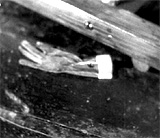
Alice's Glove Left At Crime Scene

Glove Discovered (and Concealed) by Scotland Yard Detective
Frank Webber
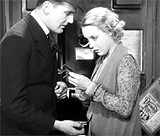
Frank Revealing to Girlfriend Alice That He Had Her Glove
|
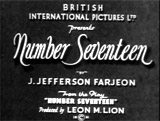
Number Seventeen (1932)
|
- the MacGuffin: a jeweled, diamond Suffolk necklace
stolen by a gang of thieves in London (Amhurst Park), and located
in a safe-house hideout on Anderson Road known as "Number
Seventeen"
- in the expressionistic opening set in a dilapidated
and abandoned mansion with cobwebs (a "house for sale or let" at
No. 17), a body was discovered on the floor (with handcuffs and
a gun) by a Cockney homeless man named Ben (Leon M. Lion) and an
undercover detective named 'Barton' (revealed at the end to be
Detective Gilbert Fordyce (John Stuart) (aka
Forsythe))
- shortly later, policeman’s daughter Rose Ackroyd
(Ann Casson) (a neighbor at No. 15) fell through the rotting roof
of the home; she claimed she was looking for her father Mr. Ackroyd
(Henry Caine), who disappeared from their home just before she
received a telegram -- "Have
Traced Suffolk Necklace to Sheldrake - Expect Him to Make
Getaway Tonight - Watch NO 17 - Will Arrive Later – Barton" --
the telegram from 'Barton' referred to a stolen necklace
and jewel thieves (led by 'Sheldrake' (Garry Marsh)) who were lured
for an anticipated rendezvous at the house at around midnight before
their escape via a trap door to a railway siding
- suddenly, the body on the floor disappeared - it
was actually 'Sheldrake' pretending to be dead;
he was
seen removing the necklace from the water-tank of a toilet, but then
Ben pickpocketed the necklace from 'Sheldrake's' pocket
- a trio of individuals (thieves looking for the necklace,
posing as house hunters) arrived at the house at 12:30 am: (1)
the gang leader's girlfriend Nora (Anne Grey), pretending to be
mute, (2) Nora's escort-husband Brant (Donald Calthrop), and (3)
their nephew, Henry Doyle (Barry Jones) (who falsely claimed in
the film's conclusion he was posing as 'Barton')
-
in the final scene, Ben revealed that the necklace was safe around
his neck and offered it as a wedding present in exchange for a ride, as he spoke to Detective
'Barton'/Forsythe and Nora: "Will you see me safely home, guv'nor,
if I gives you a nice wedding present, eh?"
|
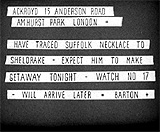
Telegram to Rose About the Rendezvous at No. 17
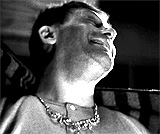
The Necklace - Worn by Ben in the Film's Conclusion
|
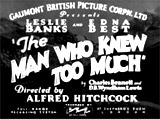
The Man Who Knew Too Much (1934)
|
- the MacGuffin: the planned assassination attempt
of a foreign dignitary that was to take place in London (seen in
a secret message intended for the British consul)
- in the plot, during a skiing holiday in St. Moritz
(Switzerland) taken by the Lawrence family, Bob Lawrence (Leslie
Banks) with his wife Jill (Edna Best), a French skier named Louis
Bernard (Pierre Fresnay) was shot and killed during dinner; as
he expired, he whispered to Jill that in his hotel room, he had
a shaving brush containing a message that must be given to the
British consul
- the enigmatic and cryptic note contained a place
name (WAPPING) and two names: G. BARBOR MAKE CONTACT A. HALL MARCH
21st.
- it was revealed that Louis Bernard had been an agent
for the "Deuxieme Bureau" and had been in the process of preventing
the assassination of a world leader-statesman
- meanwhile, the Lawrence's daughter Betty (Nova Pilbeam)
had been kidnapped; under time pressure to find his daughter and
not upset the terrorists, Bob went in pursuit of the clues in the
note; he realized that he had misunderstood, through concert tickets,
that A. Hall was not a
person but a place (Royal Albert Hall), and the assassination was
to occur there at the end of the orchestral performance during
a clash of cymbals, by a sharpshooter-assassin named Ramon (Frank
Vosper)
|
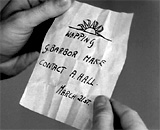
Cryptic Note: Assassination Attempt ("Contact A Hall"
- A Person or a Place?

Clue: Tickets to Albert Hall - The Location of the Assassination
|
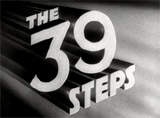
The 39 Steps (1935)
|
- the MacGuffin: the nature of the '39 Steps' (What
did 'the 39 Steps' refer to? Was it an organization or a thing?)
- the British possessed
military secrets - secret airplane engine plans (vital to the country's
air defense) that spies were attempting to smuggle out of the country
in the mind of a music hall mentalist named Mr. Memory (Wylie Watson)
- in the concluding scene set in London's Palladium,
it was revealed that the memory expert on stage held the Hitchcockian "MacGuffin" in
his head - he had memorized the classified secret information
regarding mechanical plans for the design of an airplane engine:
"The details of the Air Ministry secrets were borrowed,
memorized by this little man, and then replaced before anyone could
find out" - and after the evening's show, Mr. Memory was to be
taken out of the country by the spies, led by Professor Jordan
- when the hero Richard Hannay (Robert Donat) shouted
out the question: "What are the Thirty-Nine Steps?", Mr. Memory
dutifully answered: "The Thirty-Nine Steps is an organization of
spies, collecting information on behalf of the foreign office of..."
- but before he finished and named the country, Mr. Memory was
silenced with a gun shot that rang out from master-spy Professor
Jordan's (Godfrey Tearle) box above the stage; backstage as he
died, Mr. Memory "confessed" by
proudly reciting the complicated scientific mathematical formulas
of the secret documents that he had painstakingly memorized - the
secret formula was about how to make silent aircraft engines
|
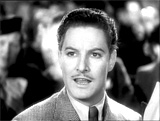
Richard Hannay (Robert Donat): "What are the 39 Steps?"
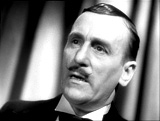
Mr. Memory (Wylie Watson)
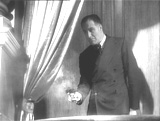
Professor Jordan - Firing at Mr. Memory From His Box
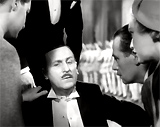
Mr. Memory - As He Died, He Recited his Memorized
Secret Plans Collected for the Spy Organization (the 39 Steps)
|
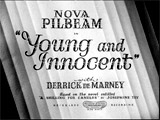
Young and Innocent (1937) (aka The Girl Was Young)
|
- the MacGuffin: the belt (used for strangulation)
from a missing (stolen?) raincoat
- in the plot, the body of international film star-actress
Christine Clay (Pamela Carme) washed up on an English coastal seaside;
her death came the morning after an argument with her jealous and
estranged ex-husband Guy (George Curzon), who still wanted to be
married to her (he said her Reno divorce wasn't valid), and accused
her of having affairs; incensed, he looked out at the sea from
the balcony, and turned back with rapidly-twitching eyes at his
ex-wife (angered and capable of foul play)
- at the scene of the crime, screenwriter Robert
Tisdall (Derrick De Marney) spotted the body and ran off to notify
authorities; police had determined that Christine
was strangled with the belt from a raincoat
- there were three reasons for Tisdall to be considered
a prime suspect, although he was wrongly-accused: (1) he was seen
running away from the crime scene, (2) Tisdall claimed that his
raincoat was recently stolen and was missing, and (3) Christine
had left him £1,200 pounds in her will (unknown to him),
suggesting that they were romantically involved with each other
- Erica Burgoyne (Nova Pilbeam), the daughter of
local police chief Colonel Burgoyne (Percy Marmont), believed in
Robert's innocence; an intense search occurred, with her help,
to search for and retrieve his raincoat to prove his alibi (if
his coat still had its belt, the one found next to Christine's
body wouldn't be his); when they questioned a local vagrant and
China-mender named Old Will (Edward Rigby) who had the raincoat,
it was learned that Will was given the coat (without a belt) by
a man with twitching eyes
- in the conclusion, a matchbook in the pocket of
the coat led to the Grand Hotel, where the killer (with the tell-tale
twitching eyes) was finally spotted - he was a blackfaced drummer
in a minstrel dance band (concealing his looks) in the hotel's
ballroom; when confronted after collapsing, he confessed to the
murder of Christine and Robert was cleared
|
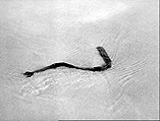
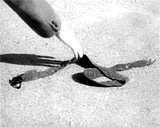
Raincoat Belt (for Strangulation)
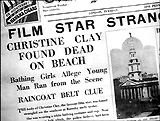
Report of Murder: Raincoat Belt Clue
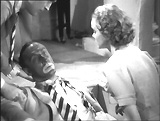
Guy (in Blackface) Confessing to Crime
|
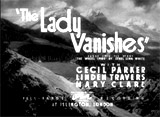
The Lady Vanishes (1938)
|
- the MacGuffin: the secret message encoded in a piece
of music sung by a folk singer-musician on the street - listened
to and remembered by Miss Froy (May Whitty) - and then the singer
was soon after murdered by strangulation - why was the singer murdered?
- another MacGuffin: the identity (and location) of
the kidnapped or disappearing elderly lady Miss Froy - why did
she vanish?
- in this tale, the person carrying the 'secret'
information disappeared (or was kidnapped) and the search for their
'secret' became a search for the person
- there was evidence! that Miss Froy existed - she
had written her name on the steamed-up carriage train window, proving
that Iris Henderson's (Margaret Lockwood) claim that Miss Froy
existed wasn't just an hallucination, but then grime from a train
tunnel covered up the evidence
- in the final scene, Miss Froy was seen in the British
Foreign Office in Whitehall, playing the tune on a piano
|
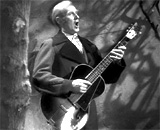
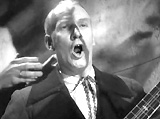
Folk Singer in Street Playing Tune - And Soon After Strangled
- But Why?
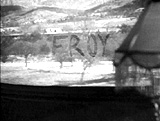
Evidence of Miss Froy Writing Her Last Name on Train Window
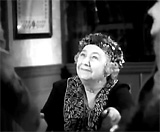
Miss Froy in the Foreign Office
|
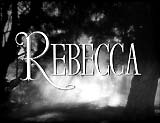
 Rebecca
(1940) Rebecca
(1940)
|
- the MacGuffin: the character
of the first Mrs.
de Winter - Rebecca (never seen on screen) - did husband Mr. Maxim
de Winter (Laurence Olivier) really love her or not, and was he
responsible for her death?
- the haunting presence of
keepsakes and the hallowed memory of Rebecca de Winter, continually
mentioned lovingly by housekeeper Mrs. Danvers to drive the second
Mrs. de Winter (Joan Fontaine) crazy
- the startling confession given by Maxim to his second
wife, about how he despised Rebecca; when she asked: "How could
I even ask you to love me when I knew you loved Rebecca still?"
- he replied with vehemence: "You thought I loved Rebecca? You
thought that? I hated her!... I never had a moment's
happiness with her. She was incapable of love, or tenderness, or
decency"; the second wife replied with disbelief - and relief:
"You didn't love her?
You didn't love her?"
- the death of Rebecca (how she died) - was revealed
by her doctor Dr. Baker (Leo G. Carroll) and her husband to be
intentional - realizing that she was terminally ill, she deliberately
goaded Maxim into accidentally killing her; Maxim was acquitted
of her murder, and her death was ruled as a suicide
|

The Deceased Mrs. de Winter
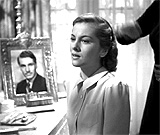
The 'Second' Rebecca - Haunted by the Memory of the
first Mrs. de Winter
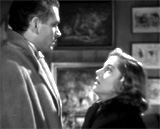
Maxim's Startling Confession of Hatred For Rebecca
|
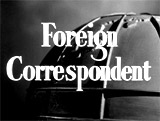
Foreign Correspondent (1940)
|
- the MacGuffin: the secret Clause 27 in a peace treaty
between Holland and Belgium, memorized by Dutch diplomat Van Meer
(Albert Bassermann) who was one of only two signatories of
the treaty; the most important clause in the treaty was never
written down, just memorized by the two; therefore, it was "a
piece of information that would be very valuable to the enemy in the
war that breaks out tomorrow, weather permitting"; the secret clause
in the treaty could either be used to avert or start the war
- in the plot, American crime reporter and 'foreign
correspondent' Johnny Jones (Joel McCrea) was selected to interview
Van Meer: "Talk
with him, find out what's in that treaty, and what he thinks is
gonna happen. Facts!"
- in the film's most striking sequence set on steep
stair steps leading down from the Amsterdam
Town Hall to the public square, Jones became suspicious when
diplomat 'Van Meer' (Samuel Adams), whom
he had already met and talked to in London, failed to recognize him
even after repeated reminders; at the same time, a press photographer
(Charles
Wagenheim) stepped up to them and asked permission for the diplomat's
photograph - a gun was concealed or hidden by his camera, and the
assassin shot 'Van Meer' to death at point-blank range in the middle
of his forehead; he tumbled down the steps
- however, as it was revealed a bit later in a windmill
outside Amsterdam, the real Van Meer was alive; the man shot was
Van Meer's impersonator, look-alike decoy
or doppelganger; as a result of the real diplomat's
knowledge, he had been kidnapped after the faked assassination
attempt by a secret international peace organization operating
as a subversive Nazi spy ring; he admitted what had happened to
Jones before being taken away: "The man you saw shot, it wasn't
me. He was a substitute that looked like me...They want the world
to think that I've been assassinated. Yes. To conceal the fact
that I'm in their hands"
- the film revolved
around trying to locate and save the diplomat ("Holland's
strongman") (and prevent his torture) - he was allegedly the
key to maintaining peace in Europe in 1939
- in the long run, the MacGuffin became unimportant
when Van Meer was rescued (and the leader of the spy ring
was uncovered); the film ended with reports that Germany had invaded
Poland and Denmark, and was bombing Norway
|
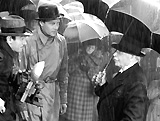
Reporter Jones and Photographer-Assassin with Diplomat
Van Meer (actually an Imposter!)
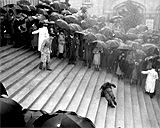
Assassination of Van Meer - Faked
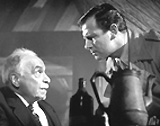
At the Windmill - The Real Van Meer Was Alive
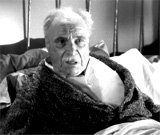
Van Meer - Kidnapped and Alive, But Tortured
|
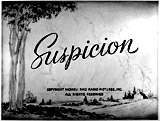
Suspicion (1941)
|
- the MacGuffin: the overriding question: was playboyish,
irresponsible, untrustworthy, and penniless con-artist and gambler
Johnnie Aysgarth (Cary Grant) also a killer or not? did he marry
his wife just for her money? was he plotting his rich wife's murder?
- Johnnie's wife Lina McLaidlaw-Aysgarth (Joan Fontaine) continually
suspected that her husband was going to murder her - when he played
word games, all she could see was the word 'murder,' and when he
read a book about a killer, she thought it was a manual for his
own deeds to poison her
- the character of naive Englishman 'Beaky' Thwaite
(Nigel Bruce), Johnnie's friend and financial partner - was the
catalyst that caused Lina to ultimately suspect
that husband Johnnie was a murderer, when 'Beaky' was found dead,
traveling with Johnnie; after Lina learned of the death, the skylight
above her in the hallway cast a web-like shadow over her as if
she was in a cage - and the next victim?
- in the "glass of milk" sequence, Johnnie brought
bed-ridden Lina a glass of milk (was it poisoned?), ascending
the stairs with the luminous glass
- however, by film's end in a tacked-on ending, it
was revealed that Lina had been entirely wrong about Johnnie; he
was planning on taking out a life insurance policy on himself and
then committing suicide, in order to cover his debts
|

Suspicions of Murder
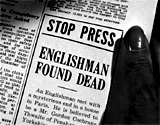
"Beaky" Suspiciously Dead in Europe
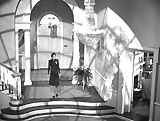
Trapped - Shadows Cast a Cage Around Lina
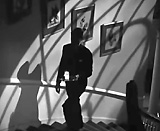
Johnnie With a Glass of Milk for Lina (was it poison?)
|
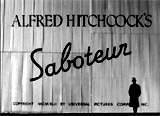
Saboteur (1942)
|
- the MacGuffin: the elusive whereabouts of Frank
Fry (Norman Lloyd), an arsonist-saboteur who was part of a cabal
of 'fifth columnists' and terrorists who were plotting to destroy
Hoover (Boulder) Dam and a USS naval battleship in Brooklyn, among
other things, including in the first scene the burning of a
Los Angeles defense aircraft factory
|
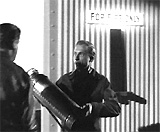
Fry with a Tampered Fire Extinguisher

Frank Fry - On Way to the Statue of Liberty
|
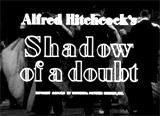
Shadow of a Doubt (1943)
|
- the MacGuffin: incriminating items that would reveal
the evil identity of Charles Oakley (Joseph
Cotten), a serial murderer (of rich widows
for their money) shown in the opening sequence
- upon arrival in Santa Rosa, CA, homicidal Uncle
Charlie gifted a stolen emerald ring to Young
Charlie Newton (Teresa Wright) with incriminating initials engraved
inside - a major MacGuffin
- after Young Charlie's sleuthing at the library to
read the days' newspaper (her family's paper had been destroyed
by Charlie) - she came upon an article about the 'Merry Widow'
murderer; she learned that the MW Murderer's third victim's name
matched the engraved initials on the ring Uncle Charlie gave her
(TS From BM): TS (Thelma Schenley) From BM (Mrs. Bruce Matthewson)
- the film's major turning point
|
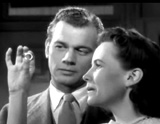
The Gift of a Ring From Uncle Charlie to Young Charlie
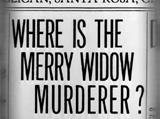
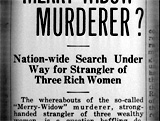
The Destroyed Newspaper Article
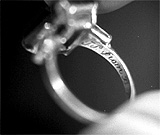
Young Charlie's Ring Engraving
|
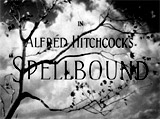
Spellbound (1945)
|
- the MacGuffin: the many mysterious instances of parallel lines
(fork lines on the tablecloth, train tracks, a bank teller's bars,
robe stripes, patterns on a bedspread, and sledding tracks outside
a window) - and the search for their real meaning
- why did the lines or patterns haunt and agitate
the sanity of the replacement head for Green Manors, a Vermont
psychiatric hospital - a young Dr. Anthony Edwardes (Gregory Peck)? --
was it due to a forgotten murder from the past?
- the MacGuffin, in essence, was Dr. Edwardes' memory
of his past and some traumatic event
- Dr. Constance
Petersen (Ingrid Bergman), the hospital's only female psychologist
- discovered that the signature on the note slipped to her by Dr.
Edwardes was markedly different from his autograph in his book
(Labyrinth of the Guilt Complex); she suspected he was a fraud,
although was falling in love with him
- through sleuthing and psychoanalyzing his phobia
(or "guilt complex"), Dr. Edwardes came to cured; he admitted
he was an imposter (his real name was John Ballantyne or J.B.),
had amnesia, was on-the-run, and had possibly killed the real Dr.
Edwardes; he also remembered a traumatic childhood incident of
pushing his brother off a bannister, accidentally causing him
to be impaled by the spires of an iron gate; his recovered memory
revived him and inspired him to save Constance from skiing off
the same steep slope on which Dr. Edwardes, in JB's presence, fell
to his death
- the MacGuffins in the story ultimately climaxed
to reveal the unmasking of the real killer of Dr. Edwardes, Dr.
Murchison (Leo G. Carroll), the long-time head of the institution
who didn't want to be retired; he had shot Dr. Edwardes on the
ski slope
|
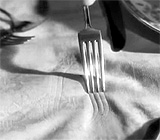
Fork Tracks

Comparison of Signatures
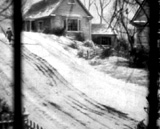
Parallel Sledding Tracks in Snow Seen Outside Window
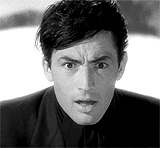
Remembering Traumatic Event of Childhood On Ski Slope
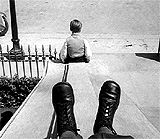
Childhood Trauma
|
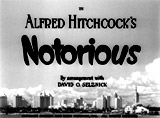
 Notorious (1946) Notorious (1946)
|
- the first MacGuffin: the importance of the key to
the mansion's wine cellar - only one key existed, and it was in
the possession of Nazi sympathizer Alexander Sebastian (Claude
Rains) in Brazil; Alex's
wife Alicia Huberman (Ingrid Bergman) took the wine cellar key
off Alex's key ring and passed it to Devlin (Cary Grant)
- the second main MacGuffin: radioactive
material (uranium ore or "vintage
sand") found in a locked cellar's wine bottles that was being
smuggled; it was discovered when one bottle smashed onto the floor
and revealed uranium powder being mined in the mountains of Brazil
by the Nazis
- another very secondary MacGuffin was the poison
in the coffee used to slowly kill Alicia
|

The Key to the Wine Cellar Hidden in Alicia's Hand

The Key Slipped to Devlin
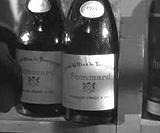
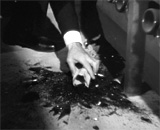
Uranium Sand Discovered Hidden in Wine Bottles
|

Rope (1948)
|
- the MacGuffin: the whereabouts of David Kentley
(Dick Hogan), continually the main item of discussion in the film
by guests at a dinner party
- (David's corpse had been stuffed into an old
wooden chest in the middle of the room - that was to be used as
a buffet table!)
- tension was created because the body might
be discovered at any moment by the guests
- another MacGuffin: the rope - out in the open -
used for the strangulation murder of David, and then dangled about
and used to tie up a bundle of books
- a secondary MacGuffin: the wrong hat (the victim's
monogrammed hat) picked up by Rupert (James Stewart)
|
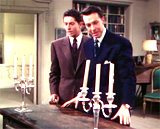
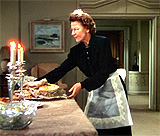
The Chest Holding the Body - Chosen as The Dinner Party's
Buffet Table
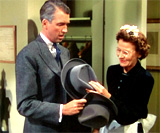
The Mix-Up in Hats
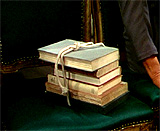
The Rope Used to Tie Books Together
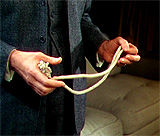
The Murder Weapon Used to Strangle David
|
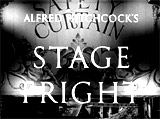
Stage Fright (1950)
|
- the MacGuffin: the blood-stained dress - allegedly
worn by stage actress/singer Charlotte Inwood (Marlene Dietrich)
when she murdered her husband
- Charlotte's secret lover was another actor named Jonathan
Cooper (Richard Todd); in a flashback, he claimed that Charlotte was
wearing the blood-stained dress, and came to his door to confess
right after killing her husband during a quarrel; in his account,
he described how he went back to her house to get her a clean dress,
and also arrange the murder scene to make it look as if there had
been a robbery; however, he had to flee when Charlotte's maid Nellie
Goode appeared and identified him
- Jonathan became
the prime suspect - but was he framed by Charlotte, or was he really
involved? - as Jonathan evaded police, an investigation commenced,
and at times, it appeared that Charlotte was the guilty one
- in the conclusion, it was revealed that Charlotte
had conspired to kill her husband, but it was Jonathan who had
committed the deed (with Charlotte present); he admitted that his
earlier 'flashback' story was a lie - he was the one who had smeared
blood onto the dress, and had killed her husband out of jealousy
when Charlotte ended her relationship with him
|

The Bloody-Dress
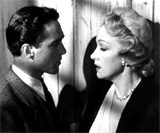
Jonathan with Charlotte
|
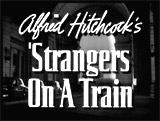
Strangers on a Train (1951)
|
- the MacGuffin: Guy Haines' (Farley Granger)
cigarette lighter, monogrammed with "A to G" and
with a symbol of two criss-crossed tennis rackets -- it was a gift
from Guy's girlfriend Anne Morton (Ruth Roman) to him
- the lighter was to be used as incriminating evidence,
to be planted by villainous psychotic Bruno Antony (Robert Walker)
in order to frame Guy for murder
- in the conclusion, as Bruno died from being crushed
under a carousel, he refused to clear Guy, but his hand opened
- revealing Guy's lighter (and innocence)
|
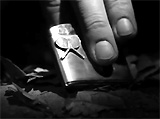
Guy's Cigarette Lighter

Guy's Lighter Revealed in Bruno's Opening Dead Hand
|

I Confess (1953)
|
- the MacGuffin: the privileged
or confidential information wanted by the police - a Catholic confession
- the information was contained in an admission-confession
given by sexton Otto Keller
(O.E. Hasse), a German immigrant and housekeeper; he made the confession
(of an accidental murder of crooked lawyer
Vilette (Ovila Légaré)), to his
Catholic priest Father Michael Logan (Montgomery Clift) in Quebec
City
|
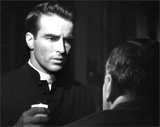
Confessional Given by Otto Keller to His Priest Father
Logan
|
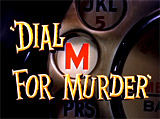
Dial M for Murder (1954)
|
- the MacGuffin: the duplicate latch-keys to the Wendice
apartment - especially the one hidden under the stair carpet outside the
apartment - the one that incriminated Tony Wendice (Ray Milland)
in the final scene when he let himself in with the stair's key
- revealing that he had designed the murder plot against his wife
- the key under the stair's carpet was his wife Margot’s
(Grace Kelly) own duplicate house key, which Tony snuck out of
her handbag and put under the stairway carpet outside their door
- it was put there to let wife-murderer Capt. Lesgate/Swann (Anthony
Dawson) into the apartment, in a plot with Tony
- during the murder,
Lesgate was specifically instructed to enter with the key, commit
the murder, then exit out the way he came, lock the door, and replace
the key under the stairs - however, after opening the door, Swann
returned the key to its hiding place immediately
- during the investigation after the botched murder,
Tony made an incorrect assumption - he postulated inaccurately that
Swann must still have Margot's latch-key (from the stairs) on him
in his pocket; so he surreptitiously took the key from Swann's
pocket (Swann's own apartment key) and placed it back in Margot's
purse; this mistake would ultimately lead to a self-incriminating
display of his own guilt
|
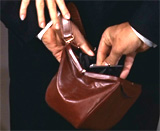
Tony Sneaking Margot's Housekey Out of Her Handbag
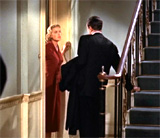
Tony Positioning Margot's Key On Stairway for Swann to Use For Entry
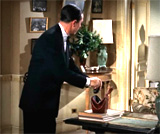
After the Botched Murder, Tony Placed Swann's Key Back Into Margot's Purse
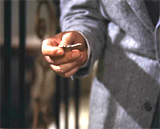
The Latch-Key From Stairway Used to Open Door in Film's
Concluding Scene
|

 Rear
Window (1954) Rear
Window (1954)
|
- the MacGuffin: the suspected 'murder' committed
by apartment tenant and traveling salesman Lars Thorwald (Raymond
Burr) across the courtyard, of his bed-ridden wife Mrs. Emma Thorwald
(Irene Winston)
- the lingering question: what happened to her?
- there was circumstantial evidence that was slowly
pieced together (a saw and butcher knife wrapped in newspaper,
the moving of a heavy trunk, the removal of jewelry from the wife's
handbag, a strangled dog that had snooped in the courtyard's garden,
etc.)
|
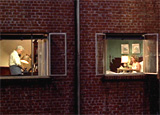
Mr. and Mrs. Thorwald
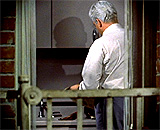
Mr. Thorwald's Suspicious Packing
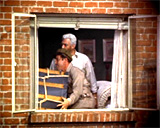
Trunk Carried Out
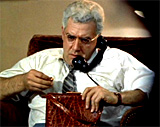
Taking Jewelry From Wife's Left-Behind Handbag
|
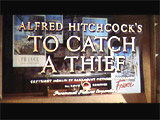
To Catch a Thief (1955)
|
- the MacGuffin: the identity of the cat-burglar who
committed a daring, night-time burglary (jewel theft) in the opening
sequence set on the Riviera - the perpetrator was suspected to
be reformed burglar John Robie (Cary Grant) (nicknamed "The
Cat")
- in the film's conclusion during a costume ball,
Robie finally proved he was innocent and caught the real masked copycat
thief - young blonde Danielle Foussard (Brigitte Auber), who was
dangled from the roof until she confessed that her father Foussard
(Jean Martinelli) and restaurateur Bertani (Charles Vanel) had
planned all of the robberies [Note: Danielle was the daughter of
the head waiter at Bertani's restaurant]
|
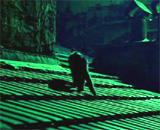
Who was the Figure in Black - a Cat Burglar?
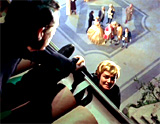
Cat Burglar Revealed
|

The Trouble With Harry (1955)
|
- the MacGuffin: the corpse, found on a hill in the
Highwater, Vermont forested countryside
- there were many diversionary elements to the murder
mystery plot and its MacGuffin - the frantic search of townsfolk
(some of whom believed they were guilty) to learn:
- WHAT or WHO killed the victim
- HOW did the victim die
- WHO was the victim (identified as Harry Worp from Boston, played by
Philip Truex)
- the story's plot told more about its characters and
their relationships than about the central (and titular) dead man
- a perfect MacGuffin
- the main dilemma (a story of cover-up) turned out
to be: WHAT TO DO WITH THE BODY (that was buried and redug up several
times to avoid police charges) - especially to conceal it from being
discovered by Deputy Sheriff Calvin Wiggs (Royal Dano)
- in the conclusion, the town's Dr. Greenbow (Dwight
Marfield) announced that Harry died of natural causes - presumably
a heart attack, although the corpse had a bump on its head, and Jennifer
Rogers (Shirley MacLaine) admitted that at her doorstep that morning,
she had whacked Harry (her second ex-husband who abandoned her) with
a milk bottle in the head (and he presumably staggered up into the
forest and died)
|
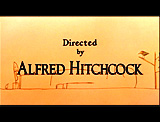
Opening Credits: Sketch of Harry's Body

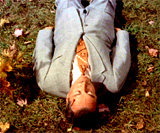
First Views of Harry

The Lifeless Corpse - Viewed at Ground Level (After
His Shoes Were Stolen by a Tramp)

Last Frame of Film
|
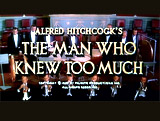
The Man Who Knew Too Much (1956)
|
- the MacGuffin: it was the warning (a whispered
message from a dying man) that there was to be an assassination
of a foreign statesman in London - and that the authorities must know
about "Ambrose Chappell"
- in the plot, the McKenna family, Dr. Ben McKenna (James
Stewart) and his famous singer-wife Jo Conway McKenna (Doris Day),
while in Marrakesh, French Morocco, became acquainted with French
businessman Louis Bernard (Daniel Gelin); the next day in the town
square during an acrobatic show, a dark-skinned man lethally wounded
in the back with a knife stumbled into Ben's arms and whispered: "A
man, a statesman is to be killed...assassinated...in London, soon,
very soon. Tell them in London to try...Ambrose Chappell"; the
man was Louis Bernard in disguise; Ben transcribed the man's words,
later given on a note to Jo; it was revealed that
Bernard was a known agent of the Deuxieme Bureau (the French version
of the FBI)
- after their young son Hank McKenna (Christopher Olsen)
was kidnapped, the couple returned to London where Ben received anonymous
phone calls and was pressured to keep silent; nonetheless, Ben
went on a search for a person named 'Ambrose Chappell'
- it was Jo who
understood that 'Ambrose Chappell' was an actual place, Ambrose Chapel,
where she and Ben found further clues to the assassination plot
- the film climaxed during a performance at the Royal
Albert Hall where the assassination attempt of the foreign prime
minister was thwarted
|
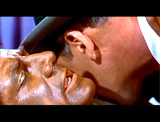
Dying Louis Bernard's Misinterpreted Whispered Words
About Assassination Plot
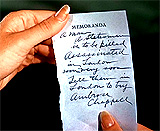
Assassination Attempt Written in Note

Ambrose Chapel - a Place in the Phone Book, not a Personal Name
|

The Wrong Man (1956)
|
- the MacGuffin: would Stork Club musician
'Manny' Balestrero (Henry Fonda) ever be cleared of the crime (assault
and robbery) he allegedly committed?
- Christopher Emanuel “Manny” Balestrero
was arrested on suspicion of robbery of an insurance company, and
due to circumstantial evidence (a spelling mistake, and his similar
appearance to the actual criminal) was arrested and booked - he
was only released after the real crook was apprehended for robbing
a delicatessan and clearly was 'Manny's' double in a case of mistaken-identity
|
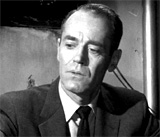
Wrongly-Accused Manny Balestrero (Henry Fonda)
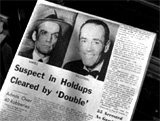
The Two Identical-Looking Suspects
|

 Vertigo
(1958) Vertigo
(1958)
|
- the MacGuffin: the spirit of a dead woman known
as Carlotta Valdes, motivating obsessed Scottie Ferguson (James
Stewart) to investigate what possessed or haunted his beloved but
now-dead Madeleine Elster (Kim Novak), Carlotta's great-granddaughter
- a suspicious link between Carlotta
and Judy was established when Judy (who was dressed to look like
Madeleine at Scottie's insistence) decided to wear Carlotta's red-ruby
heirloom necklace (it revealed that Judy was involved in the on-going
deception of pretending to be Madeleine, who actually didn't exist)
- two secondary MacGuffins: Madeleine herself (non-existent),
and Scottie's crippling fear of heights and vertigo
|
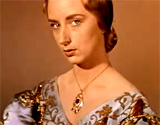
Carlotta Valdes - With Necklace
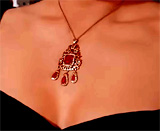
Judy Linking Herself to Carlotta (and Madeleine) by Wearing Her Necklace
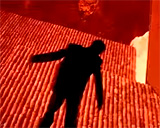
Scottie's Nightmarish Fear of Heights
|

 North by Northwest (1959)
North by Northwest (1959)
|
- the MacGuffin: the existence
of CIA agent "George Kaplan" (mistakenly
thought to be Cary Grant's character Roger Thornhill) who was being
chased by spies, but 'George Kaplan' didn't really exist
- the true definition of a MacGuffin - was revealed
to be the central nature of Roger O. Thornhill's identity, based
upon his own initials: R-O-T - with the middle initial implying "nothing"
- another MacGuffin: "government secrets" on
microfilm were hidden in a Pre-Columbian statue of a warrior that
was being smuggled out of the country by the spies, led by Philip
Vandamm (James Mason)
|
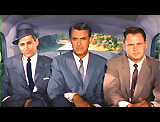
Roger Thornhill (Cary Grant) Seized and Identified as
the Non-Existent "George Kaplan"

Roger's R.O.T. Initials
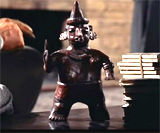
Statue with Microfilm
|

 Psycho
(1960) Psycho
(1960)
|
- the original MacGuffin: $40,000 of stolen money
(in an envelope), taken from the realtors' Phoenix office by employee
Marion Crane (Janet Leigh), who intended to run off with her debt-ridden
lover Sam Loomis (John Gavin)
- at the Bates Motel run by nervous, suspicious and
creepy proprietor Norman Bates (Anthony Perkins), Marion had second
thoughts and regrets about the theft and was planning on returning
the $40,000 the next day
- the money was ultimately wrapped up in a newspaper
in the motel bedroom - discarded, and sunk in the trunk of the
murdered Marion's car into a swamp, by Norman, to allegedly cover
up for the stabbing shower murder of Marion by a female figure
(his mother?) wielding a knife
- a new MacGuffin then surfaced - the
apparent existence of Norman's invalid, bed-ridden mother who lived
in the house perched on the hill behind the hotel - she might be
able to help in the search for the whereabouts of Marion; and then
came a second brutal murder; Detective Milton Arbogast (Martin
Balsam) was assaulted at the top of the stairs - again by the knife-wielding,
dress-wearing figure; was Norman's mother (Mrs. Bates) responsible
for both murders?
- the entire plot was upturned when the town's Sheriff
Chambers (John McIntire) described how Mrs. Bates had died over
ten years earlier in a double-murder suicide: ("Well, if the woman
up there is Mrs. Bates, who's that woman buried out in Greenlawn
Cemetery?")
|
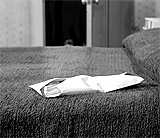
$40,000 in envelope on Marion's Bed
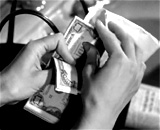
Marion Counting the Money
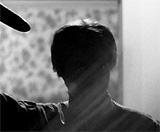
The "Mother" Figure Involved in Shower-Stabbing Death of Marion
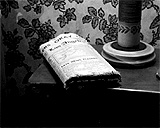
The Money Wrapped in LA Newspaper in Bates Motel Room
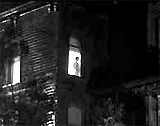
The Shadow of "Mother' in The Window of the Bates Motel's House
|
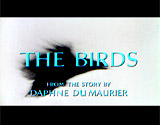
The Birds (1963)
|
- the main MacGuffin: the unexplained cause, explanation
or reason for the strange bird attacks in the town of Bodega Bay
- hypothesized by many in the Tides Restaurant attack sequence;
however, ultimately, there was no solid, rational reason why the
birds were attacking - they were not seeking revenge for nature's
mistreatment, or foreshadowing doomsday, and they didn't represent
God's punishment for humankind's evil
- one of the more insightful reasons given was an
hysterical mother's (Doreen Lang) vicious attack on rich and
glamorous socialite Melanie Daniels (Tippi Hedren) for bringing
some kind of chaotic "evil" into town: "Why are they doing this?
Why are they doing this? They said when you got here, the whole
thing started. Who are you? What are you? Where did you come from?
I think you're the cause of all this. I think you're evil. (Shrieking)
EVIL!"
- earlier in the film, it
was noted that Melanie was known for destructive and expensive
practical jokes that often back-fired on her ("Don't you remember
one of your practical jokes that resulted in the smashing of a
plate-glass window?"), and later, Melanie's notorious reputation
as a jet-setting rich socialite was recollected in another scandalous
report about her cavorting naked (as a jaybird?) into a fountain
(birdbath?) in Rome the previous summer
- the underlying MacGuffin: the nature of the conflicted
romance between Melanie Daniels and Mitch Brenner (Rod Taylor)
- symbolized by a gift of two love-birds; the attacks were mysteriously
related to the mother and son relationship in the film - Mitch's
jealous, initially hostile mother Lydia Brenner (Jessica Tandy)
expressed anger (and fears of abandonment or being left lonely)
that came to the surface when her bachelor son Mitch brought
home the attractive young Melanie
- it was clear that the "birds" (females) in the film,
including Lydia, Melanie, and the town's schoolteacher Annie Hayworth
(Suzanne Pleshette) (Mitch's former girlfriend) were circling and
flocking around, seeking attention and affection from the sole,
emotionally-cold male lead
|
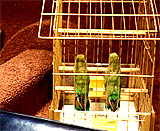
Melanie and Mitch - Symbolized by Lovebirds
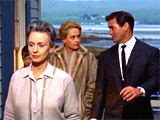
Lydia, Melanie, and Mitch
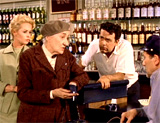
Reasons Suggested for Bird Attacks by Ornithologist Expert
Mrs. Bundy (Ethel Griffies)

Hysterical Mother's Accusation Against the "Evil" Melanie
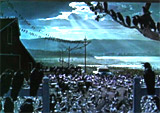
The Birds' Takeover of Bodega Bay
|
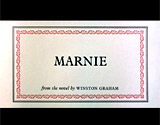
Marnie (1964)
|
- the MacGuffin: thunderstorms and the color red that
triggered or caused deep-rooted psychological problems and neuroses
for Marnie, but why?
- it was eventually explained that Marnie experienced
extreme childhood trauma - seen in flashback - that occurred during
the murder of her mother's abusive sex partner, drawing red blood
- the revelation of the root of Marnie's problems
occurred in the Baltimore home of her crippled mother Bernice Edgar
(Louise Latham) during a thunderstorm; she remembered (and relived)
how her prostitute-mother's leg was broken by a Sailor client (Bruce
Dern), and to come to her mother's aid, she struck the Sailor on
the head with a fireplace-poker and killed him; subsequently, her
mother took the blame for the crime
|
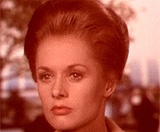
The Color Red - Triggering Fear

Flashback: Murdered Sailor
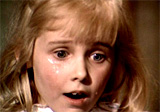
Young Marnie at Scene of Crime
|

Torn Curtain (1966)
|
- the MacGuffin: the secret formula of mathematical equations (known
by East German scientist and Professor Gustav Lindt (Ludwig Donath))
for an anti-nuclear device or anti-missile defense rocket that
the East Germans had been developing to compete with the American
anti-missile program known as "Gamma Five"
- Professor Lindt, a member of a secret spy ring that
had defected to E. Germany, was tricked by US physicist and rocket
scientist Michael Armstrong (Paul Newman) into divulging the entire
complicated equation on a classroom blackboard; the scientist boasted:
"But it works! In Russia we built it, it works!"; Armstrong congratulated
him: "My God. That's brilliant. You jumped a step, didn't you?";
the Professor bragged: "Of course it's brilliant. It's genius.
The Russians thought I was crazy. They didn't know I'm Lindt";
but then realizing his mistake and that he had revealed everything
without learning anything himself, he mused: "You
told me nothing. You know nothing" - he ordered Armstrong: "I forbid
you to leave this room"
|
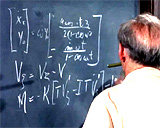
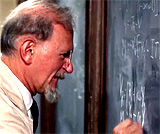
E. German Prof. Lindt Goaded Into Revealing Mathematical
Equations
|
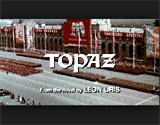
Topaz (1969)
|
- the MacGuffin: the identity of Topaz -- What or
who was Topaz? Who was in Topaz? What was its function?
- Topaz was revealed to be the
code-name for a Soviet spy ring working in France, or the name
of a Communist mole in the French government, leaking documents
to the Soviet KGB
- in the film, Topaz (French traitors) were exposed
by high-ranking Soviet intelligence officer Boris Kusenov (Per-Axel
Arosenius), a defector to the West
- Jacques Granville (Michel Piccoli)
was the leader, code-named 'color-blind'
- NATO official
Henri Jarré (Philippe
Noiret) was second in command
- another MacGuffin: visiting Cuban revolutionary
Rico Parra's (John Vernon) red leather briefcase held NATO diplomatic
documents ('aide memoire') - secret Russian plans for Cuba that
were signed between the Soviet Union and Castro's Cuba - photos
were secretly taken of the documents
- another MacGuffin-esque element in the film: the
microfilm (hidden in a slim volume of poetry) that revealed the
unloading of Soviet missiles in Cuba (seen in pictures taken by
underground members Carlotta and Pablo Mendoza); the evidence was
given to French intelligence Chief André Devereaux
(Frederick Stafford) by his undercover counter-revolutionary mistress
Juanita (Karin Dor) before he left Cuba
|
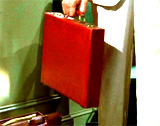
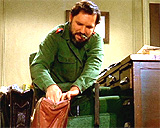
Rico Parra's Red Leather Briefcase
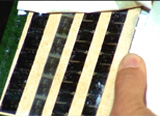
Hidden Strips of Microfilm in Book of Poetry Given to
Andre Devereaux by Juanita
|

Frenzy (1972)
|
- the MacGuffin: the necktie-killer Bob Rusk's (Barry
Foster) distinctive tie pin (with the initial R inset with diamonds)
- it had to be removed from his tie before he raped and strangled
his female victims
- the tie-pin was left behind at the scene of the
crime after the killing of Barbara "Babs" Milligan (Anna
Massey) - it was clenched in her corpse's hand
(her stiff body suffering from rigor mortis was stuffed
in a potato sack and loaded into the back of a truck-lorry); Rusk
was forced to jump into the back of the lorry and pry open her
hand to retrieve the tie-pin, as the vehicle moved along during
the night - a tense sequence
- in the conclusion, Rusk was found about to deposit
his latest half-naked female victim into a trunk for
disposal; he was pointedly asked by Chief Inspector Timothy Oxford
(Alec McCowen): "Mr.
Rusk, you're not wearing your tie"
|
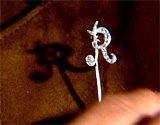
Rusk's Incriminating Initialed/Monogrammed Stickpin
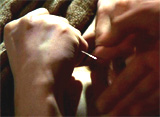
Removing the Tie-Pin From a Corpse's Hand

"Mr. Rusk, you're not wearing your tie!"
|

Family Plot (1976)
|
- the MacGuffin: the search in California for a nephew
named Edward Shoebridge
- during a seance session in the home of
elderly spinster Julia Rainbird (Cathleen
Nesbitt) conducted by 'Madame' Blanche Tyler (Barbara Harris), Julia
confessed that her deceased sister Harriet had borne an illegitimate
son 40 years earlier who was then adopted by the Shoebridges and
had become estranged from the family; Julia feared that the missing
heir, named Eddie Stonebridge, was angry and deserved part of her
inheritance fortune
- it was discovered that Eddie, who had
his adoptive parents murdered and faked his
own death (there was an empty grave and tombstone dated 1950),
was now posing with a new name in San Francisco: Arthur Adamson
(William Devane) (nicknamed "The
Trader") and operated a jewelry store in the city
- the subplot: Adamson, with his wife Fran (Karen
Black) was kidnapping rich or wealthy persons, followed by the
demand for ransoms (of gemstones and diamonds)
- in the conclusion, the location of the stolen jewels
was discovered by Blanche - a crystal chandelier in the Adamson
home, near the staircase where they wouldn't be noticed
|
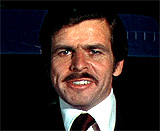
Edward Shoebridge (aka Arthur Adamson) - a jewel thief
and kidnapper
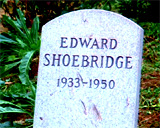
Faked Death, Tombstone Erected Over Empty Grave

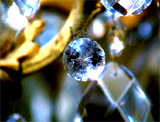
Diamond Hidden or Concealed in Crystal Chandelier
|
